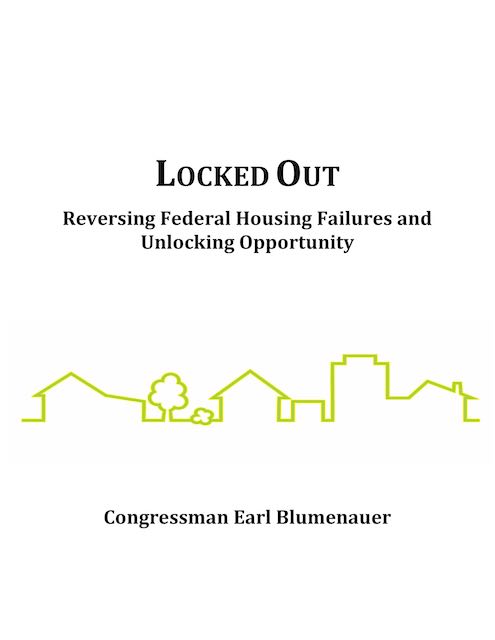
“Housing is a human right,” asserts Oregon’s U.S. Representative Earl Blumenauer in a paper titled Locked Out: Reversing Federal Housing Failures and Unlocking Opportunity.” That’s debatable, but if Blumenauer really believes it, then why does he support Oregon’s land-use laws that heavily restrict suburban development? After all, that’s the only kind of housing development that is truly affordable.
Click image to download this 28 - page report.
Blumenauer was a first-term state representative in 1973, when the legislature passed the state’s land-use law, and he’s been around enough since then to know how urban-growth boundaries have driven up land prices in the cities. Yet his paper completely ignores the role of this law in creating the housing crisis.
“There is a housing crisis in virtually every community across America,” Blumenauer states incorrectly. In fact, there are housing crises only in regions that have restricted rural land use in order to prevent so-called sprawl. But by claiming housing is unaffordable everywhere, Blumenauer diverts attention away from his own role in causing Oregon’s housing crisis.
Instead, he blames the crisis on the federal government because it isn’t building enough “public housing.” He cites Roosevelt’s New Deal as an attempt to come to grips with housing, but the housing problem in the 1930s was far different from today.
Moreover, the communities built by the New Deal and its successors were often unlivable. Most of the high rises built with federal funds were torn down because they spawned so much crime that people wouldn’t live in them even if they were free. The New Deal itself built communities of single-family homes, but then tried to control how people lived in those communities.
As Diane Ghirardo showed in her book, Building New Communities: New Deal America and Fascist Italy, the New Deal towns were more fascistic (in the sense of being dictatorial) than the Italian ones. People who bought homes in them weren’t allowed to modify their homes or change their landscaping. They were required to grow vegetables in their gardens and participate in community programs.
People who failed to suck up to housing officials were evicted for having an “improper attitude.” Buyers were given 40-year mortgages and prepayment penalties were severe so that residents could be under the government’s thumb for the longest possible time. Moreover, they weren’t allowed to resell their homes except to people deemed acceptable to the government.
As soon as Eisenhower took office, he got rid of the prepayment penalties and other government controls. Yet things are not much better today. The government builds “affordable homes” that it sells for less than market value to people whose incomes are below the median — which can mean as much as $115,000 a year in San Francisco — but the homes came with several catches. First, owners can’t resell them at market value but can only ask what they paid for them plus inflation, and can only sell them to people with similar financial disadvantages. Second, once in the homes, they are subject to intrusive reviews by the government agency that built them, not significantly different from what the New Deal did in the 1930s and 1940s.
In short, government housing is second-class housing. Despite this, Blumenauer laments that a much smaller percentage of Americans live in such housing than people in many European countries.
Even if these problems didn’t exist, almost all government housing built costs anywhere from 25 to 100 percent more per square foot than private housing. The latest trend, of course, is “tiny homes,” made necessary because the government can’t afford to build regular-sized homes for people. Oregon is 98.7 percent rural, yet it has run out of land for people to build regular homes. California is 95 percent rural, yet it too has run out of land.
“The market fails to produce an adequate supply of affordable housing,” claims Blumenauer. Sorry, Congressman, the problem is not the market. It is the government. If the government would get out of the way, the market would build plenty of housing. Instead, Blumenauer’s proposals would step up government interference in the market, a prescription for making things worse.
This article first appeared on The Antiplanner
Randal O'Toole is an economist with forty years of experience critiquing public land, urban, transportation, and other government plans.













